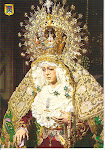
The origin of the devotion to the Virgen de la Regla can be traced back to St. Augustine. It was this great saint who hand-carved the first image of the Virgen de Regla and made her the patroness of the Rule of what is the present-day Order of St. Augustine. As a founder, St. Augustine made reglas or rules for the members of his Order to follow. He dedicated these reglas or rules to the Virgin, thus making her the Virgin of the Rule of St. Augustine. Why is the image of the Virgen de la Regla dark? Contrary to what many people presume, the image of the Virgin is dark not simply because its original statue is made of wood but because its devotion developed in Africa. St. Augustine, who died in the year 430, was from Hippo in north Africa.
Since the setting was Africa, the original image was probably made by St. Augustine to harmonize with the color of the people who would be its first devotees. Since most Africans were dark-skinned, a dark-skinned patroness would give them a sense of familiarity and closeness. It is because of its dusky color that both in Africa and in Spain the Virgen de la Regla is also known as La Virgen Morena (The Brown Virgin). The first image of Virgen de la Regla brought to Opon was a painting. It was brought by Fr. Francisco Avalle when he was installed as its first parish priest in 1735. The painting was originally from the Monastery of Nuestra Señora de la Regla in Chipiona, Andalucia, Spain, where Fr. Avalle lived and received religious education for ten years. In Opon, he made use of the painting to introduce to the islanders the devotion to the Virgen de la Regla. This lovely painting of the Virgin, which was retouched in 1873, has survived the passage of time and is currently displayed for veneration at the hagkanan, a special room set apart for the Virgin at the back of the Opon church, above the sacristy.
The traditional statue that is encased in glass and can be viewed by the faithful inside the hagkanan is the first copy of that lovely painting. The finely-chiseled statue was carved sometime in 1735 as ordered by Cruz Lauron, a prominent native of the island. He had the statue carved to thank the Virgin for curing him from a terminal affliction. If my calculation is correct, both the painting and the statue of the Virgin we see in the hagkanan are at least 264 years old. In 1954, the patroness of Opon was put in the limelight. The year was declared as a Marian Year and the Shrine of the Virgen de la Regla was designated as the Official Pilgrimage Place for the Archdiocese of Cebu. On that year, the church of Opon became the single most visited place in the whole of Visayas. According to statistics, at least 200,000 pilgrims flocked to Opon to pay homage to the Virgin.
The Archdiocese of Cebu held the first Archdiocesan Marian Congress on that same year. At the conclusion of the congress, on November 27,1954, the Virgen de la Regla was canonically crowned by the late Julio Cardinal Rosales in the presence of an estimated 300,000 people at the Capitol Site. The crowns for the Virgin and for the child Jesus used in the canonical coronation were earlier blessed by His Holiness Pope Pius XII in Rome. Today the Virgen de la Regla stands as a symbol and pride of the island. Opon is synonymous with Virgen de la Regla. Everyday hundreds of pilgrims from different parts of the country come to Opon to offer candles, flowers, letters and even their precious jewelry to thank the Virgin for favors received. Some come to kiss or simply touch the Virgin and pray for her intercession. There are also those donate clothes for the Virgin. The reservation for the clothes already goes beyond the year 2,000. The Saturday morning votive mass offered in her honor is always well-attended rain or shine. The multitude of people who attend the celebration of the Virgin's fiesta, which happens every 21st of November, is a revelation of the number of her devotees. Well, the devotees are countless. Why is the Virgin so dear to many? Because to many of her devotees she is their unfailing mother and their hope.











No comments:
Post a Comment